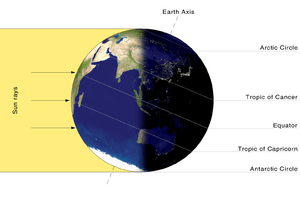Winter solstice facts for kids
The winter solstice is a special moment when one part of the Earth is tilted farthest away from the Sun. This causes that part of the world to have its shortest day and longest night of the year. After the winter solstice, the days slowly start to get longer again.
Contents
How Earth Moves Around the Sun
Our Earth is always moving around the Sun in a path shaped like an oval. As it travels, the Earth is also tilted on its axis, like a spinning top. This tilt is why we have different seasons. The sunlight hits the Earth at different angles throughout the year.
At certain times, the Sun's rays shine directly over specific parts of the Earth.
- Around the start of spring and autumn, the Sun's rays shine directly over the equator.
- Around June 21, the Sun's rays shine directly over the Tropic of Cancer (which is 23.5 degrees north of the equator). For people in the Northern Hemisphere, this is their Summer Solstice. It's their longest day and shortest night. But for people in the Southern Hemisphere, this is their Winter Solstice. It's their shortest day and longest night.
- Around December 21, the Sun's rays shine directly over the Tropic of Capricorn (which is 23.5 degrees south of the equator). For people in the Southern Hemisphere, this is their Summer Solstice. It's their longest day and shortest night. But for people in the Northern Hemisphere, this is their Winter Solstice. It's their shortest day and longest night.
When is the Winter Solstice?
The exact date of the winter solstice can change slightly each year.
- For the Northern Hemisphere, the winter solstice usually happens around December 21. On this day, the Sun is directly over the Tropic of Capricorn in the south.
- For the Southern Hemisphere, the winter solstice usually happens around June 21. On this day, the Sun is directly over the Tropic of Cancer in the north.
What Does "Solstice" Mean?
The word "solstice" comes from two Latin words:
- Sol means "sun."
- Sistere means "to stand still."
So, "winter solstice" means the "Sun stands still in winter." This name comes from how the Sun seems to pause in its path across the sky before changing direction.
History of the Date
The date of the winter solstice has been celebrated around December 21 since 1582. This was when Pope Gregory XIII introduced the Gregorian calendar. This calendar is the one most of the world uses today.
Images for kids
-
Sunlight directed through the 17 arches of Seventeen Arch Bridge, Summer Palace, Beijing around winter solstice
-
Neolithic site of Goseck circle in Germany. The yellow lines show where the sun rises and sets on the winter solstice.
-
Sunrise at Stonehenge in southern England on the winter solstice
See also
 In Spanish: Solsticio de invierno para niños
In Spanish: Solsticio de invierno para niños






